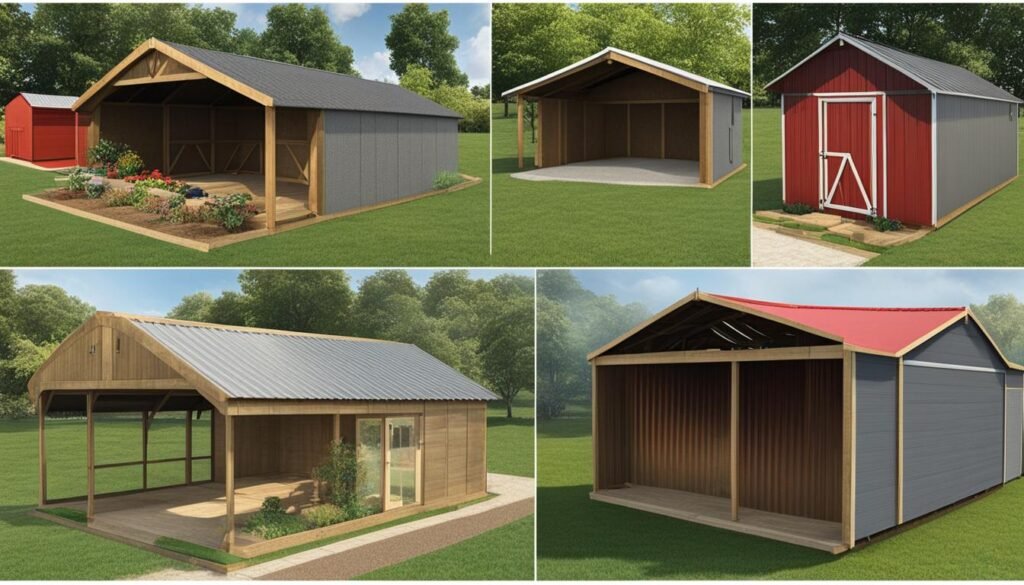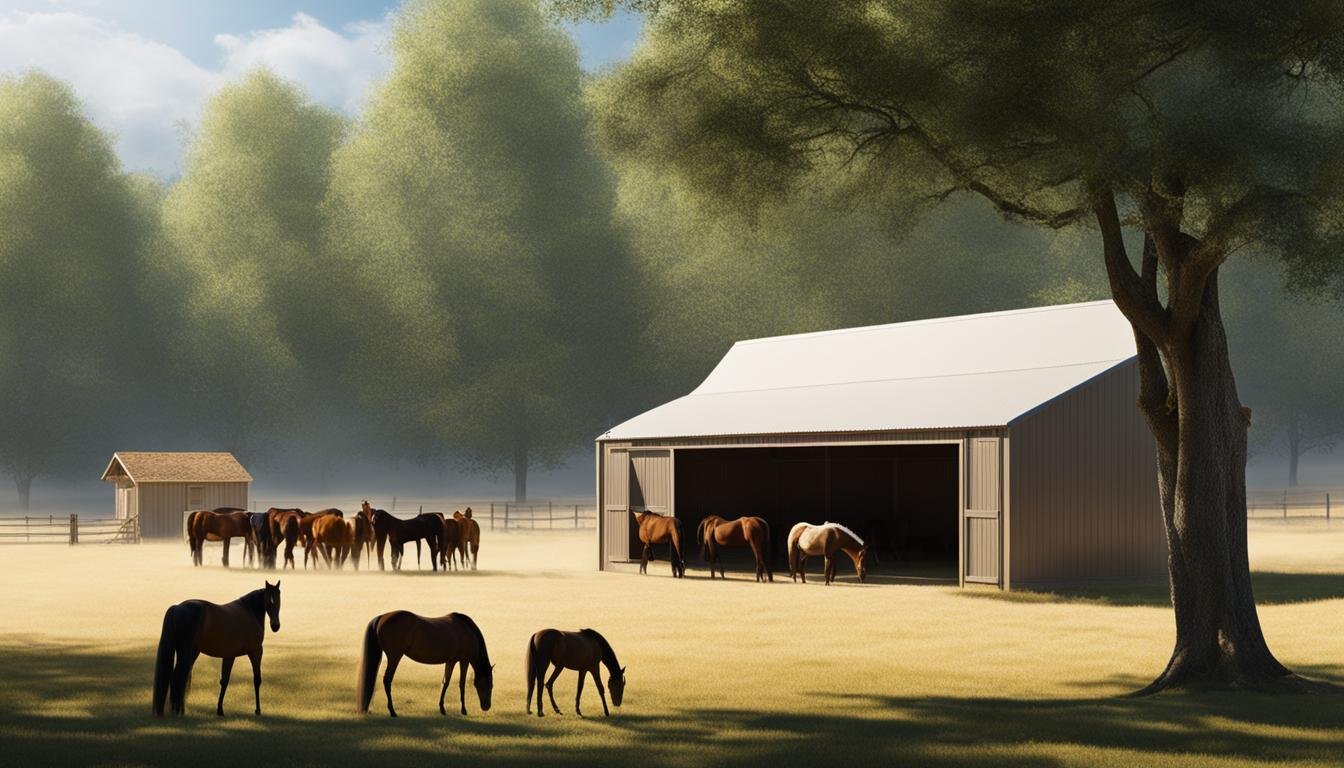A loafing shed, also known as a run-in shed, is a small three-sided structure built in a paddock or training area. It provides shelter and protection for horses from the elements such as the hot sun, cold wind, and rain. A loafing shed allows horses to freely enter and exit, giving them the option to seek shelter when needed. It is a convenient and practical solution for horse trainers, ensuring the safety and well-being of the horses.
The benefits of a loafing shed include providing horses with a secure and covered space to rest and relax, allowing them to stay outside for longer periods of time, and reducing the risk of stress, weight loss, and poor health due to exposure to harsh weather conditions.
Key Takeaways:
- A loafing shed is a three-sided structure built in a paddock or training area to provide shelter for horses.
- It allows horses to seek shelter from the sun, wind, and rain, ensuring their well-being and safety.
- The benefits of a loafing shed include providing horses with a secure and covered space to rest, reducing the risk of stress, weight loss, and poor health.
- Loafing sheds are convenient for horse trainers and allow horses to stay outside for longer periods of time.
- By using a loafing shed, horse owners can ensure their horses’ comfort and protect them from harsh weather conditions.
Considerations for Building a Loafing Shed
When planning to build a loafing shed, there are several important considerations to keep in mind. The design of the shed plays a crucial role in providing a comfortable and safe environment for horses. One key factor to consider is the size of the loafing shed. It should be spacious enough to accommodate all the horses and allow them to move freely inside. Equine research recommends a wider-than-deep design, with a large opening at the front for easy access. The lowest parts of the door opening and roof should be at least three to four meters high to ensure sufficient headroom for the horses.
Another factor to consider is the interior space of the loafing shed. It is recommended to provide each horse with at least 30 square meters of space to ensure their comfort. For properties with multiple horses, it may be more practical to have multiple smaller loafing sheds instead of a single large one. This allows for better separation and reduces the risk of injury or conflicts between horses.
The location and base preparation of the loafing shed are also crucial considerations. The ground should be dry and provide solid footing for the horses. Consulting experts and considering the use of materials such as fine stone dust or a concrete pad covered with a rubber mat can ensure optimum comfort for the horses. Additionally, the choice of materials for the loafing shed should be based on the weather conditions and durability. Structural steel is recommended for areas prone to extreme weather conditions, while wood-framed sheds offer a rustic look and durability.
Choosing a Loafing Shed
When choosing a loafing shed, it is essential to consider factors such as size, design, and material. The size of the shed should be based on the number of horses that will be using it and their individual space requirements. The design should prioritize the comfort and safety of the horses, with features such as wide openings and sufficient headroom. As for materials, consider the climate and durability. Metal-framed sheds are lightweight and easy to maintain, while wood-framed sheds offer a classic look and long-lasting durability.
Ultimately, the choice of a loafing shed should be based on the specific needs and preferences of the horses and the property owners. Consulting with experts and considering the individual requirements of the horses can help in making an informed decision.
Importance of Ventilation and Maintenance
A well-ventilated loafing shed is crucial for the health and comfort of horses. Proper airflow helps regulate temperature, reduce humidity, and prevent the buildup of mold or bacteria. To ensure sufficient ventilation, consider adding windows, shutters, or vents near the roof of the shed. These features allow fresh air to circulate during the summer months and prevent condensation in colder weather.
Regular maintenance is vital to keep a loafing shed in optimal condition. Regular cleaning is necessary to remove debris and dirt that can harbor harmful bacteria or contribute to the growth of mold. Inspections should be conducted periodically to identify any damage or wear and tear that require repairs. It’s also important to ensure the shed remains secure and stable, particularly during strong winds or storms.
Additional features can enhance the functionality and safety of a loafing shed. Consider installing kickboards to protect horses from potentially harmful contact with the shed’s metal siding. In areas prone to wildfires, opt for fire-resistant materials to minimize the risk of fire damage. By prioritizing ventilation and maintenance, you can create a safe and comfortable environment for horses in a loafing shed.
Types of Loafing Sheds
Loafing sheds come in various types, each suited for specific needs and preferences. The most common types include metal-framed loafing sheds and wood-framed loafing sheds. Metal-framed sheds are lightweight and easy to maintain, but may not be as durable as wood-framed sheds. They are susceptible to rust and may require on-site setup. Wood-framed sheds, on the other hand, offer durability and a rustic aesthetic. Treated lumber and exterior paneling make them highly durable and resistant to elements.
Siding options for loafing sheds include metal, wood, and fabric. Metal siding is fire-resistant and easy to clean but may require the installation of kickboards for horse safety. Wood-sided sheds have a classic rustic look but are vulnerable to pests and may shrink or expand with temperature and humidity changes. Fabric-sided sheds are affordable and easy to assemble but not suited for long-term use.
Finding the Right Type
When choosing a loafing shed, consider factors such as the climate in your area, the frequency of use, and your budget. If you live in an area with extreme weather conditions, a metal-framed shed with fire-resistant siding may be a better choice. However, if you prefer a more traditional and sturdy option, a wood-framed shed with treated lumber may be the way to go.

No matter what type of loafing shed you choose, ensure that it meets your horse’s needs in terms of size, ventilation, and protection from the elements. Proper maintenance and regular inspections are key to keeping your loafing shed in good condition for years to come.
Cost and Placement of Loafing Sheds
Now that you understand the benefits and considerations of building a loafing shed, let’s talk about the cost and placement. The cost of a loafing shed can vary depending on factors such as size, materials, and additional features. Prefabricated loafing sheds typically range from $4,000 to $9,500, with smaller sizes starting around $4,115. It’s important to keep in mind that while metal-framed sheds may be cheaper initially, they may incur additional setup and maintenance costs over time.
When it comes to placing your loafing shed, location is key. It should be positioned in a high, well-drained area with good ventilation. Consider placing the shed to block cold winter winds while providing shade in the summer. Take note of prevailing wind direction and sunlight patterns when determining the shed’s orientation. Avoid placing the shed under trees to prevent falling branches. Consulting experts and observing your horses’ behavior can help you determine the ideal placement for your loafing shed.
Remember, investing in a loafing shed is an investment in your horses’ well-being and safety. By providing them with a secure and comfortable shelter, you can ensure that they have a place to seek refuge from harsh weather conditions. Plus, a well-placed loafing shed can enhance their overall outdoor experience and allow them to graze and relax for longer periods of time. So, consider the cost and placement factors carefully to make the best decision for you and your horses.
FAQ
What is a loafing shed?
A loafing shed, also known as a run-in shed, is a small three-sided structure built in a paddock or training area to provide shelter and protection for horses from the elements.
What are the benefits of a loafing shed?
A loafing shed provides horses with a secure and covered space to rest and relax, allows them to stay outside for longer periods of time, and reduces the risk of stress, weight loss, and poor health due to exposure to harsh weather conditions.
What factors should be considered when building a loafing shed?
When building a loafing shed, factors to consider include the size of the shed, the location and base preparation, the choice of materials, and adequate ventilation.
What types of materials can be used for building a loafing shed?
The choice of materials for a loafing shed can include metal, wood, and fabric, depending on the desired durability, aesthetic, and weather conditions of the area.
How much does a loafing shed cost?
The cost of a loafing shed can vary depending on factors such as size, materials, and additional features, with prefabricated loafing sheds ranging from $4,000 to $9,500.
Where should a loafing shed be placed?
A loafing shed should be placed in a high, well-drained area with good ventilation, positioned to block cold winter winds and provide shade in the summer. It’s important to avoid placing the shed under trees to prevent falling branches.

